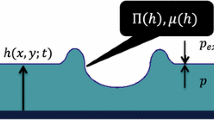Abstract
In Heat-Assisted Magnetic Recording (HAMR) technology, the lubricant layer coating on the disk is exposed to severe thermal conditions, leading to evaporation, depletion, and chemical degradation. In general, those studying the effects of laser exposure on lubricant depletion and recovery have assumed the lubricant to be a viscous fluid and have modeled its behavior using lubrication theory. However, PFPE lubricant depletion and recovery behavior at the timescale of HAMR conditions (microsecond to millisecond) is known to be that of a viscoelastic fluid. In this paper, we introduce a modification to the traditional lubrication equation that accommodates viscoelastic effects. The results suggest that this method is numerically unstable for small laser spot sizes, close to the target of HAMR. Accordingly, we developed a novel approach to model the viscoelastic depletion and recovery behavior of PFPE ultra-thin films using a Finite Element Analysis. We show that this new method is able to model the entire range of material viscoelasticity, from purely viscous to purely elastic extremes. The results show that the viscoelastic effects become remarkably pronounced with a decrease in laser spot size. For the micron-size laser spots, close to typical experimental conditions, the lubricant behaves like a viscous fluid. For the laser spot size of 20 nm, close to the target of HAMR, it behaves like an elastic material. In exposing the consequences of this viscoelastic behavior, this study predicts that lubricant flow due to thermo-capillary effects will not be a significant issue in the development of the HAMR technology. Rather, future efforts should concentrate on the thermal degradation and evaporation effects upon HAMR lubricants.












Similar content being viewed by others
References
Dahl, J.B., Bogy, D.B.: Lubricant flow and evaporation model for heat-assisted magnetic recording including functional end-group effects and thin film viscosity. Tribol. Lett. 52(1), 27–45 (2013)
Dahl, J.B., Bogy, D.B.: Simulation of lubricant recovery after heat-assisted magnetic recording writing. Tribol. Lett. 52(1), 163–174 (2013)
Sarabi, M.S.G., Bogy, D.B.: Simulation of the performance of various pfpe lubricants under heat assisted magnetic recording conditions. Tribol. Lett. 56(2), 293–304 (2014)
Marchon, B., Saito, Y.: Lubricant thermodiffusion in heat assisted magnetic recording. IEEE Trans. Magn. 48(11), 4471–4474 (2012)
Wu, L., Talke, F.E.: Modeling laser induced lubricant depletion in heat-assisted-magnetic recording systems using a multiple-layered disk structure. Microsyst. Technol. 17(5–7), 1109–1114 (2011)
Karis, T.E., Rudnick, L.R. (eds.): Lubricant Additives: Chemistry and Applications, pp. 523–584. CRC Press, Boca Raton (2009). (Chap. 22)
Itoh, S., Fukuzawa, K., Hamamoto, Y., Zhang, H., Mitsuya, Y.: Fiber wobbling method for dynamic viscoelastic measurement of liquid lubricant confined in molecularly narrow gaps. Tribol. Lett. 30(3), 177–189 (2008)
Karis, T., Marchon, B., Flores, V., Scarpulla, M.: Lubricant spin-off from magnetic recording disks. Tribol. Lett. 11(3–4), 151–159 (2001)
Scarpulla, M.A., Mate, C.M., Carter, M.D.: Air shear driven flow of thin perfluoropolyether polymer films. J. Chem. Phys. 118(7), 3368–3375 (2003)
Williams, M.L., Landel, R.F., Ferry, J.D.: The temperature dependence of relaxation mechanisms in amorphous polymers and other glass-forming liquids. J. Am. Chem. Soc. 77(14), 3701–3707 (1955)
Marchionni, G., Ajroldi, G., Pezzin, G.: Molecular weight dependence of some rheological and thermal properties of perfluoropolyethers. Eur. Polym. J. 24(12), 1211–1216 (1988)
Powell, R., Roseveare, W., Eyring, H.: Diffusion, thermal conductivity, and viscous flow of liquids. Ind. Eng. Chem. 33(4), 430–435 (1941)
Matsuoka, H., Oka, K., Yamashita, Y., Saeki, F., Fukui, S.: Deformation characteristics of ultra-thin liquid film considering temperature and film thickness dependence of surface tension. Microsyst. Technol. 17(5–7), 983–990 (2011)
Churaev, N.V., Derjaguin, B.V., Muller, V.M.: Surface Forces. Springer Science & Business Media, New York (2013)
Marchon, B.: Lubricant design attributes for subnanometer head-disk clearance. IEEE Trans. Magn. 45(2), 872–876 (2009)
Sarabi, S., Bogy, D.B.: Effect of functional end-groups on the lubricant recovery after heat-assisted magnetic recording (HAMR) writing. In ASME 2016 Conference on Information Storage and Processing Systems, American Society of Mechanical Engineers, pp. V001T01A021–V001T01A021 (2016)
Waltman, R.: Autophobic dewetting of z-tetraol perfluoropolyether lubricant films on the amorphous nitrogenated carbon surface. Langmuir 20(8), 3166–3172 (2004)
Waltman, R., Deng, H.: Low molecular weight z-tetraol boundary lubricant films in hard disk drives. Adv. Tribol. 2012, 964089 (2012). https://www.hindawi.com/journals/at/2012/964089/
Mate, C.M.: Taking a fresh look at disjoining pressure of lubricants at slider-disk interfaces. IEEE Trans. Magn. 47(1), 124–130 (2011)
Reiner, M.: The Deborah number. Phys. Today 17(1), 62 (1964)
Mendez, A.R., Bogy, D.B.: Lubricant dewetting on the sliders air-bearing surface in hard disk drives. Tribol. Lett. 61(3), 1–11 (2016)
Mate, C.M.: Spreading kinetics of lubricant droplets on magnetic recording disks. Tribol. Lett. 51(3), 385–395 (2013)
Oron, A., Davis, S.H., Bankoff, S.G.: Long-scale evolution of thin liquid films. Rev. Mod. Phys. 69(3), 931 (1997)
Wu, H., Mendez, A.R., Xiong, S., Bogy, D.B.: Lubricant reflow after laser heating in heat assisted magnetic recording. J. Appl. Phys. 117(17), 17E310 (2015)
Waltman, R.J.: Z-tetraol reflow in heat-assisted magnetic recording. Tribol. Online 11(1), 50–60 (2016)
Tichy, J.: Non-newtonian lubrication with the convected maxwell model. J. Tribol. 118(2), 344–348 (1996)
Sarabi, S., Bogy, D.B.: Effect of functional end-groups on lubricant reflow in heat-assisted magnetic recording (hamr). Tribol. Lett. 65(1), 15 (2017)
Patankar, S.: Numerical Heat Transfer and Fluid Flow. CRC Press, Boca Raton (1980)
Siginer, D.A.: Stability of Non-linear Constitutive Formulations for Viscoelastic Fluids. Springer, New York (2014)
Morozov, A., Spagnolie, S. (eds.): Complex Fluids in Biological Systems: Experiment, Theory, and Computation. Springer, New York (2014). (Chap. 1)
ANSYS, A.W.: 14.0 help documentation [db]. Mechanical APDL ANSYS Parametric Design Language Guide,
Ma, Y., Chen, X., Liu, B.: Experimental study of lubricant depletion in heat assisted magnetic recording over the lifetime of the drive. Tribol. Lett. 47(2), 175–182 (2012)
Acknowledgements
This work would not have been possible without the financial support of the Computer Mechanics Laboratory (CML) at University of California, Berkeley. Authors thank the CML sponsors for their financial and scientific support.
Author information
Authors and Affiliations
Corresponding author
Rights and permissions
About this article
Cite this article
Sarabi, S., Bogy, D.B. Effect of Viscoelasticity on Lubricant Behavior Under Heat-Assisted Magnetic Recording Conditions. Tribol Lett 66, 33 (2018). https://doi.org/10.1007/s11249-017-0979-5
Received:
Accepted:
Published:
DOI: https://doi.org/10.1007/s11249-017-0979-5




